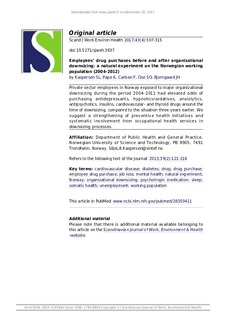Employees' drug purchases before and after organizational downsizing: a natural experiment on the Norwegian working population (2004-2012)
Kaspersen, Silje Lill; Pape, Kristine; Carlsen, Fredrik; Ose, Solveig Osborg; Bjørngaard, Johan Håkon
Journal article, Peer reviewed
Published version
Permanent lenke
http://hdl.handle.net/11250/2468836Utgivelsesdato
2017Metadata
Vis full innførselSamlinger
Originalversjon
Scandinavian Journal of Work, Environment and Health. 2017, 43 (4), 307-315. 10.5271/sjweh.3637Sammendrag
Objectives This study investigated the association between organizational downsizing and purchases of prescribed drugs by private sector employees in Norway.
Methods A natural experiment was constructed using individual-level employer and employee data linked to the national prescription database for the period 2004–2012. The study population comprised 144 089 employees who had been exposed to major downsizing in the same period. Random effects logistic regression models were used to investigate relative changes in drug purchases (antidepressants, hypnotics/sedatives, anxiolytics, and anti-psychotics, as well as anti-obesity, anti-diabetic, cardiovascular, and thyroid drugs, anti-inflammatory drugs, opioids, and analgesics/antipyretics) in the five-year-period before and after exposure to downsizing.
Results Compared with the situation three years before exposure, the odds ratios (OR) of purchasing psychotropic drugs one year after exposure increased for antidepressants (OR 1.44, 95% CI 1.34–1.55), hypnotics/sedatives (OR 1.39, 95% CI 1.29–1.49), anxiolytics (OR 1.32, 95% CI 1.22–1.43), and antipsychotics (OR 1.34, 95% CI 1.19–1.52). Similar associations were found for cardiovascular, anti-diabetic, and thyroid drugs. Stratified analyses showed that the odds of purchasing psychotropic, anti-diabetic, and cardiovascular drugs in the years around downsizing was more pronounced in men compared with women. Elevated odds were also found for employees in the oldest age group and those with less than tertiary education.
Conclusions Exposure to organizational downsizing increased the odds of purchasing prescribed psychotropic, cardiovascular, anti-diabetic, and thyroid drugs. The clinical implications of these results might be systematic involvement from medical personnel and occupational health services in workforce reduction processes.
